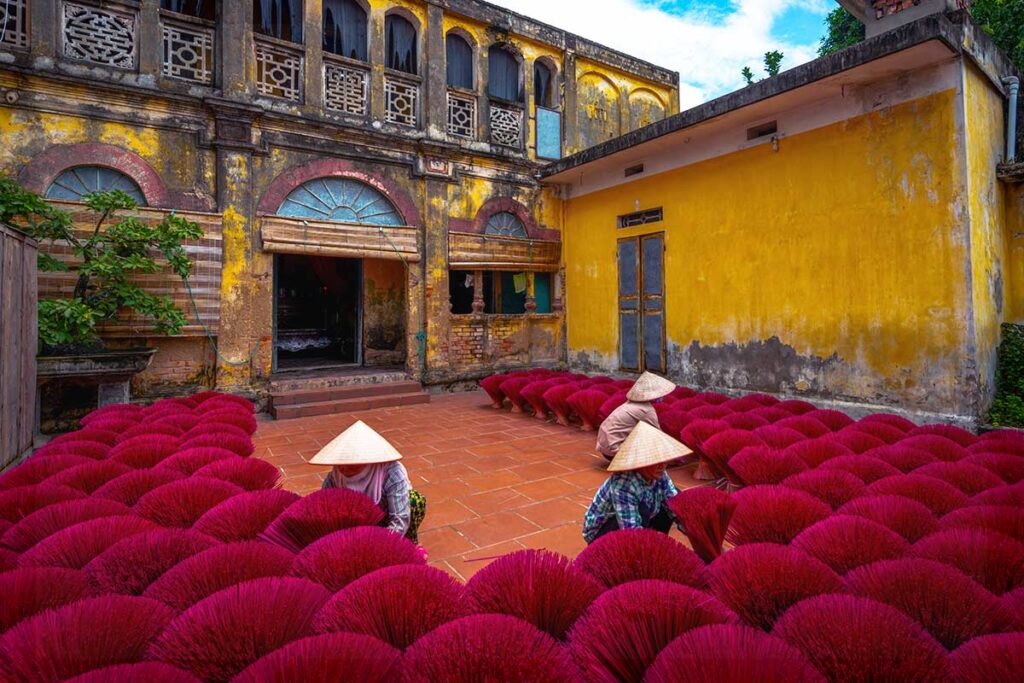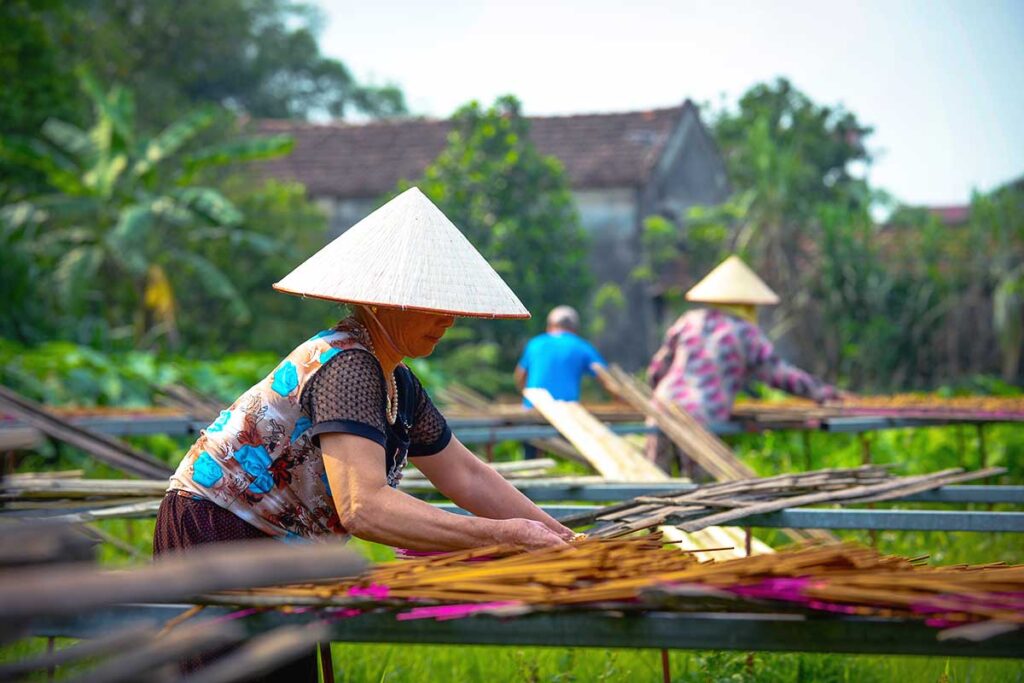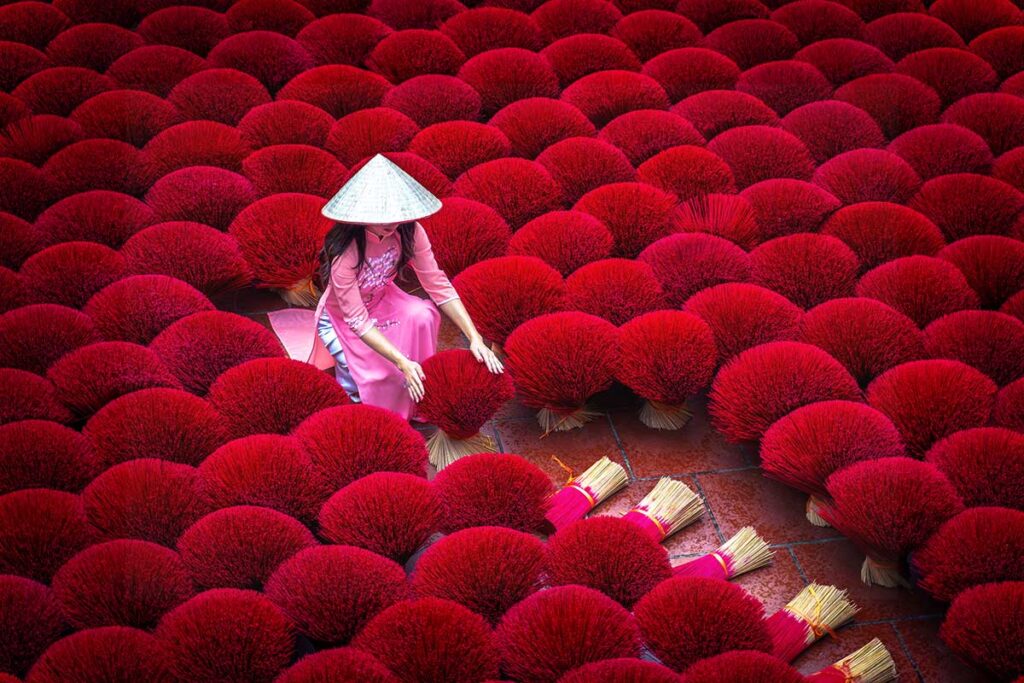
Exploring Quang Phu Cau Incense Village: Is It Worth Your Time?
Quang Phu Cau Incense Village is a short drive from Hanoi, where tradition and craftsmanship meet in a colorful and aromatic display. Known for its vibrant, fragrant incense sticks drying in the sun, this village offers a unique sensory experience that’s a must-visit for anyone interested in Vietnamese culture and traditional crafts.
Where is Quang Phu Cau Incense Village?
About the craft village
Quang Phu Cau Incense Village, located approximately 35 km (22 miles) from Hanoi, is renowned for its production of incense sticks. As you arrive, you’re greeted by vibrant colors and aromatic scents, making it a sensory wonderland. This charming village is a popular destination for tourists and photographers, thanks to the picturesque scenes created by rows of drying incense sticks along the streets.

Historical Background and Significance
The tradition of incense making in Quang Phu Cau dates back over a century, with the village crafting incense since the 19th century. Passed down through generations, this craft remains a family tradition. Incense holds a significant place in Vietnamese culture and spiritual practices, used in temples, homes, and ceremonies to honor ancestors and deities. The village’s commitment to preserving this craft underscores its cultural importance and the artisans’ dedication to their heritage.
The craft process
The incense in Quang Phu Cau is crafted from a mixture of natural materials, including bamboo, sawdust, and aromatic resins. The village produces a variety of incense types, each with its unique scent and purpose. Visitors can explore different stages of incense production and even try their hand at making their own incense sticks.
Step-by-Step Overview of the Craft:
- Bamboo Selection and Preparation: The process starts with selecting high-quality bamboo, which is then cut into thin sticks.
- Drying the Bamboo Sticks: The bamboo sticks are laid out in the sun to dry, creating the colorful scenes that the village is famous for.
- Mixing the Incense Paste: The paste is made from a blend of sawdust, aromatic resins, and natural dyes.
- Coating the Bamboo Sticks: The dried bamboo sticks are dipped into the incense paste and rolled to ensure an even coating.
- Final Drying: The coated sticks are laid out in the sun once more to dry, allowing the paste to harden and the fragrance to intensify.
Highlights of Quang Phu Cau Incense Village
1. Explore incense drying fields

Wander through picturesque fields where thousands of colorful incense sticks are laid out to dry, creating stunning visual displays. The vibrant colors and unique arrangements of the incense sticks make this a must-see attraction, offering plenty of opportunities for beautiful photographs.
2. Participate in workshops
Join immersive workshops led by skilled local artisans to learn the ancient art of incense making. These hands-on sessions offer a step-by-step guide on crafting incense sticks, from selecting the bamboo to applying the fragrant paste. It’s a fun and educational experience that lets you create your own incense to take home as a unique souvenir.
3. Visit local workshops

Watch artisans at work in their local workshops and gain insight into the detailed process of making incense sticks. Seeing the artisans’ skilled hands transform raw materials into beautiful incense is a captivating experience that fosters a deeper appreciation for this traditional craft.
4. Capture beautiful photos

Take advantage of numerous photography opportunities with vibrant colors and unique scenes throughout the village. The best lighting for capturing the stunning displays of incense sticks drying in the sun is early morning or late afternoon.
5. Experience village life
Immerse yourself in the daily life of the villagers and discover their customs and traditions related to incense making. As you walk through the village, you can witness the simple yet meaningful lifestyle of the local community and how they have preserved this craft through generations.
How to Get There from Hanoi
Directions from Hanoi:
Quang Phu Cau Incense Village is approximately 35 km (22 miles) from Hanoi.
Travel Time:
The journey takes about 1 hour by car from Hanoi to Quang Phu Cau.
Tips:
To avoid traffic and make the most of your visit, it’s advisable to start your trip early in the morning.
Best Way to Get There:
- Private Car with Driver: Hiring a private car with a driver is the most convenient way to reach Quang Phu Cau. It offers comfort and flexibility, allowing you to explore the village at your own pace. This option is preferable to a taxi for longer trips, as the driver will wait for you and bring you back to Hanoi.
- Motorbike: For more adventurous travelers, renting a motorbike offers a fun way to reach the village. The roads are generally in good condition, but always remember to wear a helmet and adhere to local traffic laws.
Exploring Quang Phu Cau Incense Village: Is It Worth Your Time?
Quang Phu Cau Incense Village can be a mixed experience depending on what you’re looking for. It’s important to manage expectations to decide if it’s worth your time.
Pros:
- Photographic Opportunities: The village is renowned for its vibrant, colorful displays of incense sticks laid out to dry. It’s a fantastic spot for photographers and Instagram enthusiasts.
- Cultural Insight: If you step off the beaten path, you can witness the detailed process of incense making, from bamboo splitting to the final product. Engaging with locals, especially with a guide, can provide a deeper understanding of this traditional craft.
- Unique Experience: The visual impact of thousands of incense sticks in various colors creates a striking, picturesque scene that’s quite different from other travel destinations.
Cons:
- Tourist Trap Elements: Some feel that the village is heavily geared towards tourists, with limited genuine interaction with the craft. Fees may apply for photography, and some interactions with locals can feel more transactional than genuine.
- Limited Activities: Apart from taking photos, there might not be much else to do. Some visitors have noted that the village is small and can be explored quickly.
Conclusion:
Quang Phu Cau Incense Village is especially appealing to photographers and Instagram enthusiasts due to its vibrant, colorful displays of incense sticks. However, for those seeking a deeper cultural experience, it might feel limited. Consider combining this visit with other attractions, such as Hanoi Train Street, for a more comprehensive experience.
Tips for Visiting the Village:
- What to Wear:
For a truly memorable photo op, consider renting an Ao Dai in Hanoi. This traditional Vietnamese dress adds an extra layer of cultural richness to your visit. - Best Time to Visit Quang Phu Cau:
To see the village at its most lively, plan your visit on sunny days when locals use every available space to dry incense sticks. The Tet Holiday (Lunar New Year) adds an extra level of activity and visual impact as production ramps up to meet festive demand. - Entrance Fee:
There is no entrance fee for Quang Phu Cau Incense Village, but a 100,000 VND fee is typically charged for photography. - Weekends:
Weekends tend to be busier with locals visiting, so if you prefer a quieter experience, consider planning your visit during the week. - Be Careful Where You Walk:
The incense sticks and other materials are crucial to the livelihood of the villagers. Be mindful not to damage them while taking photos or exploring. - Ideal Duration:
Allocate 1 to 2 hours for your visit. This timeframe allows you to see the main sights, participate in a workshop, and capture plenty of photos.
Other craft villages around Hanoi
Explore the rich cultural heritage of Hanoi by visiting its craft villages. Discover Bat Trang Ceramic Village’s beautiful pottery, Van Phuc Silk Village’s luxurious fabrics, and Duong Lam Ancient Village’s traditional architecture. Experience the unique crafts at Le Mat Snake Village, Chang Son Hand Fan Village, Chuong Conical Hat Village, and Quat Dong Embroidery Village.